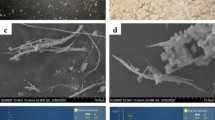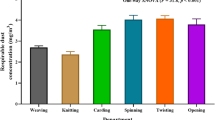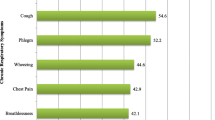Abstract
Objectives
The main purpose of this study was to assess and characterize the pulmonary reactions associated with occupational exposure to talc dust.
Methods
Ninety-seven talc workers and 110 unexposed employees as the reference group were randomly selected from a local rubber industry. Standardized respiratory questionnaires were administered to the subjects, they underwent chest X-ray and were examined by a specialist for any possible respiratory abnormality to be diagnosed. Furthermore, pulmonary function tests (PFTs) were measured just before and after the work shift. Moreover, to assess the extent to which workers had been exposed to talc dust, using standard methods, inhalable and respirable dust concentrations were measured in different dusty worksites.
Results
The average (mean ± SD) age (years), weight (kg), height (cm) and duration of exposure to talc dust (years) for the exposed group were 35.8 ± 6.75, 73.1 ± 9.2, 172.3 ± 5.9 and 11.79 ± 5.3, respectively. The corresponding values for the non-exposed group were 36.1 ± 6.87, 73.36 ± 8.1, 173.2 ± 5.7 and 0 ± 0, respectively. Atmospheric concentrations of inhalable and respirable talc dust were estimated to be 41.8 ± 23.52 and 19.8 ± 8.04 mg/m3 (mean ± SD), respectively. Talc exposed subjects had a significantly higher prevalence of respiratory symptoms. Similarly, PFTs revealed that exposure to this lubricating agent was associated with significant decreases in the mean percentage predicted of vital capacity (VC), forced vital capacity (FVC) and forced expiratory volume in the first second (FEV1). Likewise, there was a general tendency for VC, FVC and FEV1 to decrease as estimated cumulative exposure (years worked) increased. Moreover, there was an acute reduction in some parameters of pulmonary function such as VC, FVC and FEV1, over the work shift. Chest radiographs of exposed workers showed that pneumoconiosis profusions were between p 0/0 and p 2/1 according to the ILO 1980 chest X-ray classification.
Conclusions
These results that are in full agreement with our preliminary observations, support the notion that occupational inhalation exposure to talc is associated with both acute and chronic respiratory disorders and induces bronchitis and interstitial lung disease.
Similar content being viewed by others
Notes
Stepwise multiple regression is a method in which all of the potential independent variables (all together) with each and every dependent variable are entered in the model. Therefore, the model excludes the non significant variables and retains the significant ones.
Increased if person usually have cough and phlegm
References
ACGIH (2001) Threshold limit values for chemical substances and physical agents (TLVs and BELs). In: Biological exposure indices. ACGIH Worldwide, USA, p 54
Coggiola M, Bosio D et al (2003) An update of a mortality study of talc miners and millers in Italy. Am J Ind Med 44(1):63–9
Delaude A (1977) Talc-related pathology. Bull Acad Natl Med 161(2):405–409
EL-Ghawabi SH, el-Samara GH, Mehasseb H (1970) Talc pneumoconiosis. J Egypt Med Assoc 53:330–340
Eula B, Barbara C, Charles HP (2001) Patty’s toxicology, vol 1, 5th edn. Wiley-Interscience, USA, p 534
Ferris BG (1978) Epidemiology standardization project. Am Rev Respir Dis 118:1–120
Fine LJ et al (1976). Studies of respiratory morbidity in rubber workers: respiratory morbidity in talc workers. Arch Environ Health 31:195–200
Flecher CM, Peto R, Tinker C, Speizer FC (1976) The natural history of chronic bronchitis and emphysema. Oxford University Press, Oxford
Gamble J, Greif A, Honcock J (1982) An epidemiological study of talc workers. Ann Occup Hyg 26(3):841
Governa M et al (1987) Ventilatory function in rubber producing workers. Acute change over the workshift. Br J Ind Med 44(2):83–89
Honda Y, Beall C, Delzell E, Oestenstad K, Brill I, Mattews R (2002) Mortality among workers at a talc mining and milling facility. Ann Occup Hyg 46(7):575–585
International Agency for Research on Cancer (1987), Monographs on the evaluation of the carcinogenic risk of chemicals to humans. Silica and some silicates. IARC, Lyon
International Labour Office (ILO)(1980). Guidelines for the use of ILO, international classification of radiographs of pneumoconiosis. Occupational Safety and Health Series, No. 48, ILO, Geneva
Kumar V, Cotran RS, Robbines SL (1997) Basic pathology, 5th edn., pp 393–425
Leophonte P, Didier A (1990) France talc pneumoconiosis. In: Bigon J (ed) Health related effects of phyllosilicates. Springer, Berlin Heidelberg New York, pp 203–206
Levy BS, Wegman DH (2000) Occupational health: recognizing and preventing work-related disease and injury, 4th edn. Little Brown, Boston, pp 497
Morgan MD, Keith WC, Seaton A (1995) Occupational lung diseases, 3th edn. Saunders, USA, pp 268–307
NIOSH (1986) Occupational respiratory diseases. Department of Health and Human Services (DHHS) No. 86- 102, USA, pp 256–260
NIOSH (1997) NIOSH manual of analytical methods, 3rd edn. Air samplers, Talc respirable (Method P355), pp 1–8
Rajaeifard A, Neghab M (2003) Respiratory symptoms and ventilatory disorders among a group of rubber workers. Toxicol Lett 144(1):104
Stellman JM (1998) Encyclopedia of occupational health and safety, 4th edn. International Labour Office, Geneva (3):62.6
Wegman DH, Peters JM, Boundy MAG, Smith TJ (1982) Evaluation of respiratory effects in miners and millers exposed to talc free of asbestos and silica. Br J Ind Med 39:233–238
Wergland E, Andersen A, Baerheim A (1990) Mobidity and mortality in talc-exposed workers. Am J Ind Med 17(4):505–13
Wild P, Réfrégier M, Auburtin G et al (1995) Study of the respiratory health of the workers of a talc pruducing factory. Occup Environ Med 52(7):470–477
Wild P, Leodolter K, Réfrégier M, Schmidt H, Zidek T, Haidinger G (2002) A cohort mortality and nested case-control study of French and Austrian talc workers. Environ Med 59:98–105
Zenz C, Dickerson OB, Horvath EP (1994) Occupational medicine, 3rd edn. Mosby, St. Louis, pp 194–231
Acknowledgments
Funding through the Shiraz University of Medical Sciences, contract No. 82-1956, supported these investigations.
Author information
Authors and Affiliations
Corresponding author
Rights and permissions
About this article
Cite this article
Neghab, M., Rahimi, E., Emad, A. et al. An epidemiological study of talc-related respiratory morbidity among employees of a rubber industry in Shiraz-Iran. Int Arch Occup Environ Health 80, 539–546 (2007). https://doi.org/10.1007/s00420-006-0161-0
Received:
Accepted:
Published:
Issue Date:
DOI: https://doi.org/10.1007/s00420-006-0161-0




